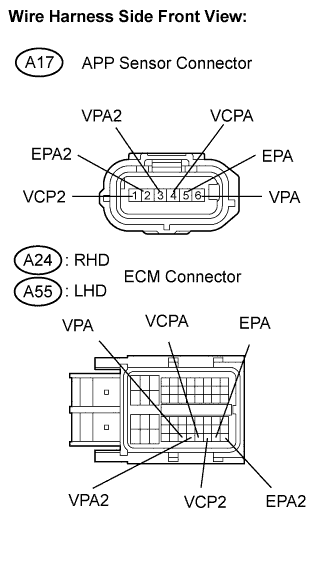DTC P2121 Throttle / Pedal Position Sensor / Switch "D" Circuit Range / Performance |
for Preparation Click here
DESCRIPTION
This ETCS (Electronic Throttle Control System) does not use a throttle cable.The Accelerator Pedal Position (APP) sensor is mounted on the accelerator pedal bracket and has 2 sensor circuits: VPA (main) and VPA2 (sub). This sensor is a non-contact type, and uses Hall-effect elements, in order to yield accurate signals, even in extreme driving conditions, such as at high speeds as well as very low speeds. The voltage, which is applied to terminals VPA and VPA2 of the ECM, varies between 0 V and 5 V in proportion to the operating angle of the accelerator pedal (throttle valve). A signal from VPA indicates the actual accelerator pedal opening angle (throttle valve opening angle) and is used for engine control. A signal from VPA2 conveys the status of the VPA circuit and is used to check the APP sensor itself.
The ECM monitors the actual accelerator pedal opening angle (throttle valve opening angle) through the signals from VPA and VPA2, and controls the throttle actuator according to these signals.

| DTC No. | DTC Detection Condition | Trouble Area |
| P2121 | Difference between VPA and VPA2 is less than 0.4 V, or more than 1.2 V for 0.5 seconds (1 trip detection logic) |
|
FAIL-SAFE
The accelerator pedal position sensor has two (main and sub) sensor circuits. If a malfunction occurs in either of the sensor circuits, the ECM detects the abnormal signal voltage difference between the two sensor circuits and switches to limp mode. In limp mode, the functioning circuit is used to calculate the accelerator pedal opening angle to allow the vehicle to continue driving. If both circuits malfunction, the ECM regards the opening angle of the accelerator pedal as being fully closed. In this case, the throttle valve remains closed as if the engine is idling.If a pass condition is detected and then the ignition switch is turned off, the fail-safe operation stops and the system returns to a normal condition.
WIRING DIAGRAM
Refer to DTC P2120 (Click here).INSPECTION PROCEDURE
- HINT:
- Read freeze frame data using the intelligent tester. The ECM records vehicle and driving condition information as freeze frame data the moment a DTC is stored. When troubleshooting, freeze frame data can be helpful in determining whether the vehicle was running or stopped, whether the engine was warmed up or not, whether the air-fuel ratio was lean or rich, as well as other data recorded at the time of a malfunction (Click here).
- This DTC relates to the Accelerator Pedal Position (APP) sensor.
| 1.READ VALUE USING INTELLIGENT TESTER (ACCEL POS #1 AND ACCEL POS #2) |
Connect the intelligent tester to the DLC3.
 |
Turn the ignition switch to the ON position and turn the tester on.
Enter the following menus: Powertrain / Engine / Data List / Accelerator Position No. 1 and Accelerator Position No. 2.
Read the values displayed on the tester.
- Standard voltage:
Accelerator Pedal Operation ACCEL POS #1
(AP#1)ACCEL POS #2
(AP#2)Released 0.5 to 1.1 V 1.2 to 2.0 V Depressed 2.6 to 4.5 V 3.4 to 5.0 V
|
| ||||
| NG | |
| 2.CHECK HARNESS AND CONNECTOR (ACCELERATOR PEDAL POSITION SENSOR - ECM) |
Disconnect the A17 Accelerator Pedal Position (APP) sensor connector.
 |
Disconnect the A24 (RHD) or A55 (LHD) ECM connector.
Measure the resistance according to the value(s) in the table below.
- Standard resistance (Check for open):
- RHD:
Tester Connection Specified Condition VPA (A17-6) - VPA (A24-55) Below 1 Ω EPA (A17-5) - EPA (A24-59) Below 1 Ω VCPA (A17-4) - VCPA (A24-57) Below 1 Ω VPA2 (A17-3) - VPA2 (A24-56) Below 1 Ω EPA2 (A17-2) - EPA2 (A24-60) Below 1 Ω VCP2 (A17-1) - VCP2 (A24-58) Below 1 Ω - LHD:
Tester Connection Specified Condition VPA (A17-6) - VPA (A55-55) Below 1 Ω EPA (A17-5) - EPA (A55-59) Below 1 Ω VCPA (A17-4) - VCPA (A55-57) Below 1 Ω VPA2 (A17-3) - VPA2 (A55-56) Below 1 Ω EPA2 (A17-2) - EPA2 (A55-60) Below 1 Ω VCP2 (A17-1) - VCP2 (A55-58) Below 1 Ω
- Standard resistance (Check for short):
- RHD:
Tester Connection Specified Condition VPA (A17-6) or VPA (A24-55) - Body ground 10 kΩ or higher EPA (A17-5) or EPA (A24-59) - Body ground 10 kΩ or higher VCPA (A17-4) or VCPA (A24-57) - Body ground 10 kΩ or higher VPA2 (A17-3) or VPA2 (A24-56) - Body ground 10 kΩ or higher EPA2 (A17-2) or EPA2 (A24-60) - Body ground 10 kΩ or higher VCP2 (A17-1) or VCP2 (A24-58) - Body ground 10 kΩ or higher - LHD:
Tester Connection Specified Condition VPA (A17-6) or VPA (A55-55) - Body ground 10 kΩ or higher EPA (A17-5) or EPA (A55-59) - Body ground 10 kΩ or higher VCPA (A17-4) or VCPA (A55-57) - Body ground 10 kΩ or higher VPA2 (A17-3) or VPA2 (A55-56) - Body ground 10 kΩ or higher EPA2 (A17-2) or EPA2 (A55-60) - Body ground 10 kΩ or higher VCP2 (A17-1) or VCP2 (A55-58) - Body ground 10 kΩ or higher
Reconnect the APP sensor connector.
Reconnect the ECM connector.
|
| ||||
| OK | |
| 3.REPLACE ACCELERATOR PEDAL ROD ASSEMBLY |
| NEXT | |
| 4.CHECK WHETHER DTC OUTPUT RECURS (ACCELERATOR PEDAL POSITION SENSOR DTCS) |
Connect the intelligent tester to the DLC3.
Turn the ignition switch to the ON position and turn the tester on.
Clear the DTCs (Click here).
Start the engine.
Allow the engine to idle for 15 seconds.
Enter the following menus: Powertrain / Engine / DTC.
Read the DTCs.
- Result:
Display (DTC Output) Proceed to P2121 A No output B
|
| ||||
| A | ||
| ||
